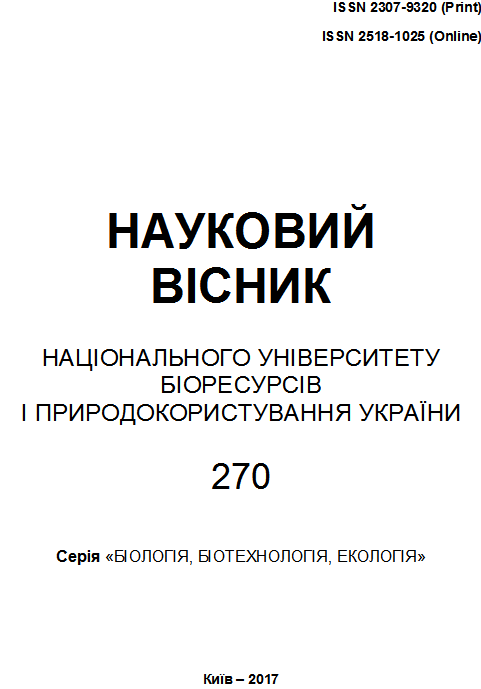CYTOLOGICAL CHANGES IN ELODEA CANADENSIS DURING BIOTESTING OF CHRONIC TOXICITY OF SURFACE WATER MONITORED IN PRYPIAT RIVER RIGHT-BANK TRIBUTARIES
Abstract
The aim of the presented work was to examine the cytological changes in Elodea canadensis after exposure of different duration during the chronic toxicity assessments of river surface water for different hydrological seasons.
The experiments were carried out at different exposure times (7, 14, 21 days). In each series of experiments, the total number of cytological changes of E. canadensis was higher in summer compared to winter. The results of toxicity biotesting of surface water in representative control sites in most cases were statistically significant compared with control (p≤0.05) in case of the 14-day exposure.
The researcher conducted a correlation analysis between the water quality indicators and biotesting parameters. Nonetheless, the total number of cytological changes in the test object was characterized by the most numerous dependencies with the medium strength of relationship. Those pairs of variables included the following: suspended solids (r=0.67), ammonia nitrogen (r=0.56), nitrate-nitrogen (r=0.59), the BOD5 rate (r=0.67), the content of dissolved oxygen (r=-0.60), zinc (r=0.52), and manganese (r=0.61).
Basing on the obtained results, the author suggests using cytological changes coefficient for the E. canadensis test object as a summarizing indicator within the biological assessment of surface water chronic toxicity. The noted indicator presents the ratio of the number of cells that are in a state of necrosis, initial necrosis and isotonic plasmolysis to the total number of analysed cells, while taking into account the duration of the plants’ exposure to the studied water samples.
References
Klymenko M., Pylypenko Yu., Hrokhovska Yu., Lianzberh O., Biedunkova O. (2015). Hidroekolohiia. Pidruchnyk. [Hydroecology. Textbook]. Kherson, Ukraine: OLDI-plius, 365.
Biotestuvannia u pryrodookhoronnii praktytsi: [zbirnyk] / Tekhnichnyi komitet z standartyzatsii TK 82 «Okhorona navkolyshnoho pryrodnoho seredovyshcha ta ratsionalne vykorystannia resursiv Ukrainy». Vydannia ofitsiine. [Biotesting in environmental practice [collection] / Technical Committee for Standardization TC 82 «Environmental protection and rational use of resources of Ukraine». [Official Publication.] (1997). Kyiv, 240.
Saksonov M., Tripuzov G., Stom D. (2007). Radiojekologicheskij monitoring reki Enisej i citogeneticheskie harakteristiki vodnogo rastenija Elodea canadensis. [Radioecological monitoring of the Yenisei River and cytogenetic characteristics of the Elodea canadensis aquatic plant]. Radiation Biology. Radioecology, 47(1), 63-73.
Saksonov M., Tripuzov G., Stom D. (1988). Metod biotestirovanija po vyhodu jelektrolitov iz kletok jelodei [The method of bioassay for the output of electrolytes from Elodea cells]. Methods of water biotesting. Chernogolovka, Russian, 96-97.
Granin A., Shevchenko A. (2006). Vlijanie azotnokisloj rtuti na fotosinteticheskuju aktivnost’ Elodea Canadensis, opredelennoj s pomoshh’ju registracii zamedlennoj fluoriscencii [The effect of nitric acid mercury on the photosynthetic activity of Elodea Canadensis, determined by recording delayed fluorescence] / Bulletin VSSC of the RAMS, 2(48), 20-21.
Kostyshyn S.S., Khorbut N.S. (2007). Morfofiziolohichni zminy Lemna minor ta Elodea canadensis v umovakh naftovoho zabrudnennia [Morphological changes Lemna minor and Elodea canadensis in terms of oil pollution] / Ecology and noosferolohiya, 18(1-2), 68-76.
Biedunkova O. (2015). Diagnostika toksichnosti poverhnostnyh vod po citologicheskim izmenenijam vysshej vodnoj rastitel’nosti [Diagnosis of surface water toxicity by cytological changes in higher aquatic vegetation]. Ecological bulletin, 1(31), 88-93.
DSTU 4107-2002 (ISO 5667-16:1998, MOD) Yakist vody. Vidbir prob. Chastyna 16. Nastanovy z biotestuvannia. [Water quality. Sampling. Part 16. Guidelines bioassay]. (2003). Kyiv: Derzhspozhyvstandart Ukrainy, 38.
Perechen’ rybohozjajstvennyh normativov: predel’no dopustimyh koncentracij (PDK) i orientirovochno bezopasnyh urovnej vozdejstvija (OBUV) vrednyh veshhestv dlja vody vodnyh obektov, imejushhih rybohozjajstvennoe znachenie [The list of fishery management standards: the maximum permissible concentrations and the roughly safe levels of exposure of harmful substances for water of water bodies that are of fishery importance]. (1994). Moscow, Russian: VNIIRO, 304.
Downloads
Published
Issue
Section
License
Relationship between right holders and users shall be governed by the terms of the license Creative Commons Attribution – non-commercial – Distribution On Same Conditions 4.0 international (CC BY-NC-SA 4.0):https://creativecommons.org/licenses/by-nc-sa/4.0/deed.uk
Authors who publish with this journal agree to the following terms:
- Authors retain copyright and grant the journal right of first publication with the work simultaneously licensed under a Creative Commons Attribution License that allows others to share the work with an acknowledgement of the work's authorship and initial publication in this journal.
- Authors are able to enter into separate, additional contractual arrangements for the non-exclusive distribution of the journal's published version of the work (e.g., post it to an institutional repository or publish it in a book), with an acknowledgement of its initial publication in this journal.
- Authors are permitted and encouraged to post their work online (e.g., in institutional repositories or on their website) prior to and during the submission process, as it can lead to productive exchanges, as well as earlier and greater citation of published work (See The Effect of Open Access).

